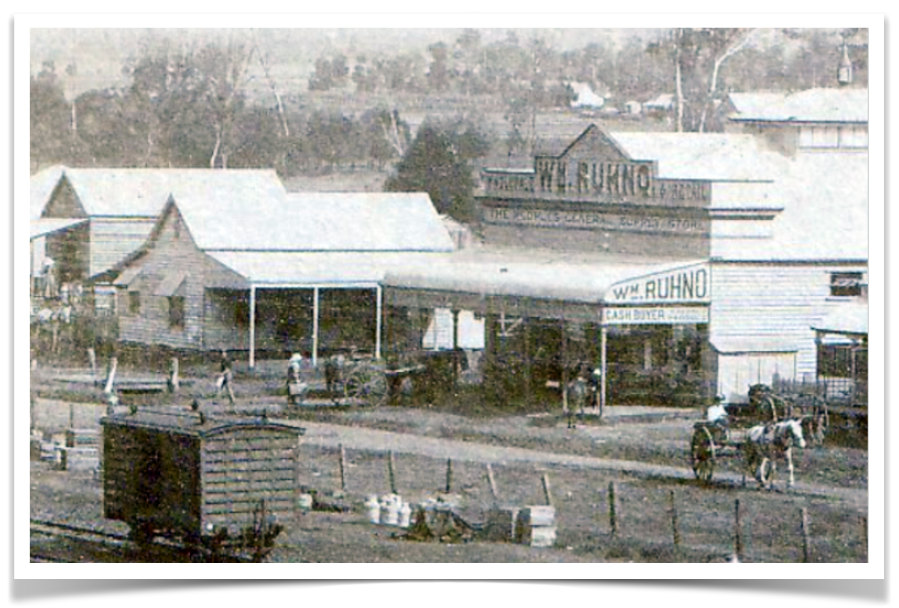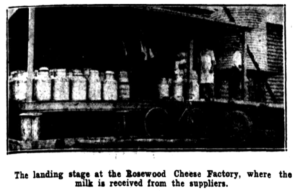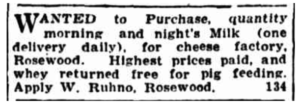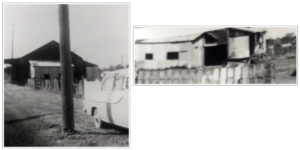
The store on the left of Ruhno’s store was newly built in 1910, not too long before this photo was taken. It later became the cheese factory.
It’s hard to see but Albert Street runs in between the two shops.
Rosewood History
Ruhno’s Cheese Factory
“The establishment of a cheese factory in Rosewood should be a considerable advantage to the man on the land, and an asset to the town generally.”
These words were written about a business transaction which took place on 5th March 1928, when William Ruhno bought the property at the corner of Railway and Albert Streets, opposite his store, from Mrs Anna Louisa Maria Muller of Redcliffe, for the purpose of building a cheese factory. Anna’s husband John Muller J.P., was previously a cream tester and Magistrate at Rosewood. Originally there was an old saddler’s shop on the block, but John Muller demolished it and built a new building in November 1910. (see main photo)
This building underwent extensive alterations in May to conform with the government regulations for the purpose of a cheese factory, and it was announced that Mr Ruhno was building a motor garage on the same property.
 The cheese factory at Rosewood commenced operations under the management of Mr John William McColm on September 4th, when the first delivery of milk was made. The process of manufacture was witnessed during the day by numerous interested spectators, and the finished product in 401b. blocks proved to be an excellent exhibit of cheese. It was thought the venture looked promising and would be very successful. (1)
The cheese factory at Rosewood commenced operations under the management of Mr John William McColm on September 4th, when the first delivery of milk was made. The process of manufacture was witnessed during the day by numerous interested spectators, and the finished product in 401b. blocks proved to be an excellent exhibit of cheese. It was thought the venture looked promising and would be very successful. (1)
To the dairymen in the Rosewood district it offered another avenue for the disposal of their product. The required quantity of milk was guaranteed, likewise a market for all the cheese the factory was capable of producing.
Mr Rhuno installed an up-to-date plant. The cool and spacious manufacturing room was 28ft. by 28ft. (8.53m x8.53m) with a concrete floor, containing two large vats and presses, and capable of treating up to 1800 gallons of milk per day (each press was capable of treating 600 gallons). The milk brought in by suppliers was received on a landing stage 26ft by 26ft (7.92m x7.92m) at the rear of the building, where it was tested and weighed and then gravitated to the vats in the manufacturing room for treatment. The whey was then ejected by means of a pump into an overhead tank, and received the following morning by the supplier for use as pig feed on the farm. One hundred gallons could be dealt with in less than ten minutes at the receiving stage so there was no delay. (2)
 Special attention was been given to the drainage system, the refuse being conveyed by cement drains into a cement tank outside the building, and is then disposed of by a fine spray a distance away in a most hygenic manner. The curing room, 28ft. by 20ft (8.53m x6 m), was built on the latest method of insulation, and fitted with shelves for storing purposes. The water supply was procured from a bore on a neighbouring property and a pasteuriser was installed. The plant was worked with a 12 h.p. engine and boiler. (1)
Special attention was been given to the drainage system, the refuse being conveyed by cement drains into a cement tank outside the building, and is then disposed of by a fine spray a distance away in a most hygenic manner. The curing room, 28ft. by 20ft (8.53m x6 m), was built on the latest method of insulation, and fitted with shelves for storing purposes. The water supply was procured from a bore on a neighbouring property and a pasteuriser was installed. The plant was worked with a 12 h.p. engine and boiler. (1)
The manager (Mr. M’Colm) had an extensive knowledge of the cheese industry, and prior to taking charge of the Rosewood factory, he had been the manager at the Greenmount Dairy Co.’s factory for 12 years. In early May 1928, John McColm took this position and moved his family to Rosewood from Greemount, a small town south of Toowoomba, known for being the boyhood home of Arthur Hoey Davis (Steele Rudd).
It appears that this venture of William Ruhno’s was short lived. I could not find any mention of the cheese factory in the ensuing years.
I found John and Ethel McColm on the 1930 electoral roll at Yargullen (also in the Toowoomba region), where John was the factory manager for the Yargullen Co-operative Dairy Association, Ltd. They had a store at Coolangatta in 1931 and around August 1932 John re-opened the East Greenmount I.X.L. Cheese Factory.
 This photo was taken about 1964. The old factory building is still there with a front awning over the footpath. Dai Berrell ran his blacksmith business in the building.
This photo was taken about 1964. The old factory building is still there with a front awning over the footpath. Dai Berrell ran his blacksmith business in the building.

Old cheese factory buildings. Cnr Railway St & Albert Street. View from Albert Street (left).
The last structure was pulled down in the late 1970s.
Photos: Courtesy of Dave Brown
© Jane Schy, 2024
Sources:
(1) Queensland Times, Tuesday, 27 March 1928, page 10
(2) The Brisbane Courier, Saturday, 20 October 1928, page13
Australian Electoral Rolls
